 UK Royal Navy (1902-1921)
UK Royal Navy (1902-1921)1908-09 program, G-class 1913:
HMS Beagle, Bulldog, Grasshopper, Harpy, Renard, Foxhound, Wolverine, Mosquito, Basilisk, Scourge, Racoon, Scorpion, Savage, Rattlesnake, Pincher, Nautilus/Grampus
WW1 British Destroyers:
26 knotters | 27 knotters | 30 knotters | 33 knotters | Turbine destroyers | River class | Cricket class | Tribal class | Beagle class | Acorn class | Acheron class | Acasta class | L class | M class | Repeat M class | Medea class | Faulknor class FL | Marksman class FL | Parker class FL | Talisman class | Shakespeare class FL | R class | S class | Repeat R class | V class FL | Scott class FL | V class | W class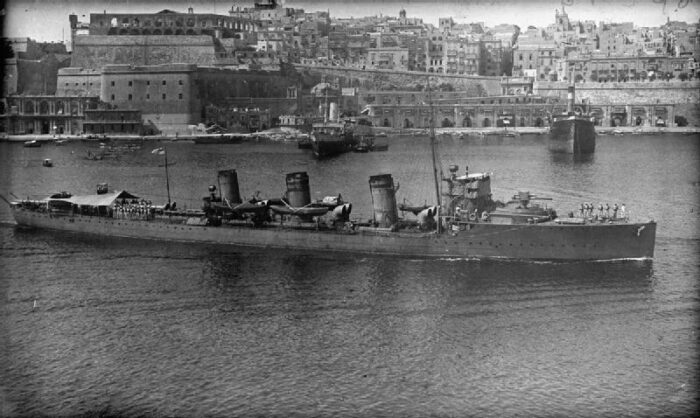
The “Beagles” or “G class” from 1913 were sixteen destroyers designed in 1908 in reaction to the costly and fragile Tribal class. The admiralty overall wanted smaller, stronger vessels running on coal, fearing the lack of oil in wartime. They had a better range, but were slower, and were generally well armed and liked overall. This design became a standard for the next classes. They formed the Ist Destroyer Flotilla on completion in April-October 1910. In 1911, they became 5th DF sent to the Mediterranean. in 1914 they were recalled for home waters, then sent to the Dardanelles to be used temporarily as minesweepers until recalled home late 1917. Two were wrecked in operations, one was sunk in collision, the remainder were discarded in 1920-21.
Development
For the destroyers of the 1908-09 Programme the Admiralty decided against a repetition of the “Tribals”, partly because of their excessive cost but also because of their fragility. There was also a strong feeling against using oil fuel, which was by then difficult to obtain. These arguments were reinformed by a report that a new German destroyer G 137 had reached a mean speed of just over 33kts on a displacement of 372t for 4 hours. Understandably, there was consternation at a coal-burner achieving the same speed as the oil-burning ‘Tribals’. A sketch design was prepared in June 1908, but oil fuel was immediately deleted, and the final design was approved the following month.
In addition to be smaller, more affordable destroyers, accent was put on range to roam the North Sea in order to likely meet the German reconnaissance forays, conditions that made the previous (also cheap) Cricket-class coastal destroyers inoperative most of the time. They had been designed as low-cost supplement to the expensive Tribals, but were modelled after 1990s destroyers, lacking a forecastle. The move from oil on the Tribals to coal was due to concerns about the availability of oil stocks in wartime, as to reduce costs, but also imposed modifications in their design, with much more space managed for extra bunkerage. But by doing that, these became the last British destroyers running on coal. After orders had been placed a 4in Mk VIII was substituted for the 2—12pdr/12cwt mounted side-by-side on the forecastle.
Design of the class
Hull and general design
The Beagles were built to a standard design, detailed design being left as before to local builders in accordance to still loose specification. In theory this eased the work of said shipyard that avoid many informations to be exchanged and trips to the admiralty, allowed to use tested recipes, and gain time and money overall. But on specifications, this was a mess as each yard came up with its own design. As a result, the ships measured between 263 feet 11+1⁄4 inches (80.45 m) and 275 feet (83.82 m) long between perpendiculars, between 26 feet 10 inches (8.18 m) and 28 feet 1 inch (8.56 m) in beam for an average draught of 8 feet 6 inches (2.59 m).
The admiralty hoped a standard tonnage of 850 long tons (860 t) but all builders missed the mark and in the end they came up at 945 long tons (960 t) normal on average, and 1,100 long tons (1,120 t) full load, again, on average.
To be precise, 3 Parsons steam turbines, 5 Yarrow boilers was the norm for all yards, but HMS Basilisk and Harpy (White, Cowes) had three Parsons steam turbines, and five White-Forster boilers.
Powerplant
The average yet again was to have five Yarrow or White-Forster boilers which fed direct-drive steam turbines, driving three propeller shafts. Total power was precised by the admiralty to be at 14,300 shaft horsepower (10,700 kW) for a top speed of 27 knots (50 km/h; 31 mph). According to this configuration they also had three funnels, heavenly spaced and raked, like the masts.
Like the “Rivers” the Beagles sacrificed nominal speed for a more realistic sea speed. In trials against the “Tribals” they repeatedly showed superior endurance and gave the admirakty all satisfaction. They were designated the “G” class from October 1913.
Armament
The Beagle class was designed to carry a gun armament of five 12-pounder (76 mm) guns side by side on the forecastle’s raised platform, either side. The port gun was however mounted ahead of the starboard gun en échelon to fire cross-deck. While under construction however, the two “puny” forecastle guns were replaced instead by a single 4-inch (102 mm) gun Mk VIII, completed by the three initially intended QF 12-pounder 12 cwt guns on deck. Torpedo armament was still very light, just two 21-inch (533 mm) torpedo tube (one between funnels and aft gun, one aft at the stern).
4-in Mark VIII/40 (101.6 mm)
These were designed in 1908 and entered service on the HMS Swift, Tribals, Beagle and Acorns.
⚙ specifications 4-in Mark VIII |
|
| Weight | 2,912 pounds (1,320 kg) |
| Barrel lenght | 159.2 inches (4.044 m) bore 40 calibres |
| Elevation/Traverse | -10° to +20°, 360 |
| Loading system | Welin single-motion screw breech |
| Muzzle velocity | 2,287 feet per second (697 m/s) |
| Range | 10,210 yards (9,340 m) |
| Crew | 8 |
| Round | 31 pds (14.06 kg) Common lyddite |
| Rate of Fire | 6-8 RPM |
QF 12-Pdr 12 cwt
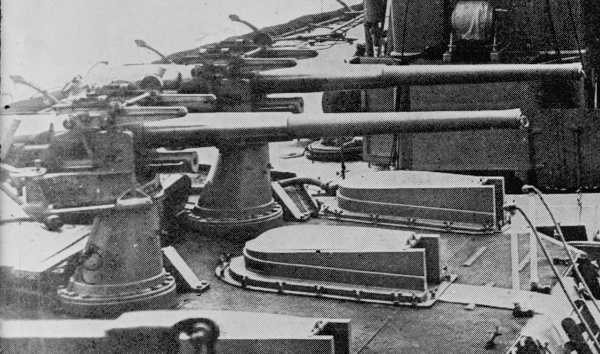
The QF 12 pounder 18 cwt gun (Quick-Firing) was a 3-inch high-velocity naval gun intended at first for battleships to deal with torpedo boats. 18 cwt referred 112 lbx2,016 lb or 914 kg unlike the strick “12 pounder” with was actually 12.5 lb or 5.7 kg. They ended on a lot of capital ships.
⚙ specifications 12-pdr, 12 Cwt |
|
| Weight | 2,016 lb (914 kg) |
| Barrel lenght | 150-inch (3.81 m) 50 calibres |
| Elevation/Traverse | |
| Loading system | |
| Muzzle velocity | 2,600 ft/s (790 m/s) |
| Range | 9,300 yards @ +20° (8,500 m @ +20°) |
| Crew | 5 |
| Round | Separate QF 12.5 lb (5.66 kg) |
| Rate of Fire | 20 rd/min |
21-in Torpedoes
The new RGF Mk VIII* 21-in torpedo with the Hardcastle heater was adopted in this class. It ran at 5Okts (93 km/h; 58 mph) over 1000yds (910 m) or 12,000yds (11,000 m) at 30kts (56 km/h; 35 mph). Two spare torpedoes were carried. A major improvement was the siting of the forecastle gun on a raised platform, but the after TT was frequently unusable right aft over the rudder (during the war it was replaced by a 3pdr AA gun in some boats).
The default when completed was the “Short” Mark I at 17 ft 10.5 in (5.448 m), and “Long” Mark I at 23 ft 1.25 in (7.042 m). The explosive charge was 200 lb (91 kg) of gun cotton, increased later to 225 lb (102 kg).
Wartime modifications included replacement of the aft torpedo tube by a 3-pounder (47 mm) AA gun in some ships and depth charges racks were fitted.
*nothing to do with the Mark VIII from 1925.
⚙ specs Mark VIII TORPEDO |
|
| Weight | 1,6t |
| Dimensions | Diameter 534 mm, Length 681 cm |
| Propulsion | Wet Heater |
| Range/speed setting | |
| Warhead | 340 kg TNT |

⚙ Beagle class specifications |
|
| Displacement | 860–940 long tons (874–955 t) |
| Dimensions | 275 ft x 27 ft 6 in x 8 ft 6 in (83.8 x 8.38 x 2.59 m) |
| Propulsion | 3 shafts steam turbines, 5 Coal-fired boilers, 12,500 hp (9,300 kW) |
| Speed | 27 knots (50.0 km/h; 31.1 mph) |
| Range | |
| Armament | 1× BL 4-in L/40, 3× QF 12-pdr 12 cwt Mark I, 2× 21 in TTs |
| Crew | 96 |
Depth Charges
By mid-March 1916 the Beagle started to be equipped with Type D depth charges, a pair of racks on at first on HMS Scorpion’s stern for tests, then the whole class. In June 1918, Harpy got her first Thornycroft depth charge throwers or “Y guns”. In all eight in two free falling racks, two launchers, 50 total in store. They represented a total extra weight of 18 tons and due to this, some had to land their aft 12-pdr gun as a tradeoff.
Fire Control
The tribals had all a one meter base rangefinder, replaced around 1916, and so did the Beagle class. They used a visual tranmission system of fire data. By mid-1918, these Beaglme obtained alarm circuits. Torpedo Control was unformized for all destroyers from “D” through “G” class destroyers: Firing gongs operated from the bridge but the Beagles had in addition a Fore Bridge Firing Gear.
Communication
All had likely the Navyphone and Telaupad network used for Fire Control as precised in the 1909 gunnery handbook. This electric system depended on 6 Pattern 1453 cells. Guns, torpedo tube and searchlight were connected to the bridge via these telaupads. A Pattern 863 navyphone was installed the fore bridge and a Pattern 2140A in the aft steering post. Both Navyphones were connected to all Telaupads. By 1915 fixed voice pipes were installed between decks, with flexible ends for gunnery and torpedoes as captains complained about the poor sound transmitted by the navyphones. The third fully flexible voicepipe ran from bridge to the forward gun.
Average destroyer cost ranged from £100,000 to £115-120,000 per yard.
Construction, upgrades and asseqsment
John Brown, Clydebank: Beagle, Bulldog, Foxhound
Fairfield, Govan: Grasshopper, Mosquito, Scorpion
White, Cowes: Basilisk, Harpy
Cammell Laird, Birkenhead: Renard, Wolverine, Racoon
Hawthorn Leslie, Hebburn: Scourge
Thornycroft, Woolston: Savage
London & Glasgow Co, Govan: Rattlesnake
Denny, Dumbarton: Pincher
Thames Iron Works, Blackwall: Nautilus, later Grampus
Given the faxct that these vessels came out from nine different yards, some producing a single ship, it’s nothing short of miraculous they came out so homogeneous after all. The admiraty’s only requirements were in the machinery, in order to prevent wild performances gaps in the class. Not only coal-burning, but also in the Parsons turbines, which were not the only provider at that stage.
Overall, they came out as a technical success and a recipie to follow on further destroyers. They kept a good seaworthiness, speed was still impressive when loaded, but over all else, they had the “legs” to accompany the Grand Fleet on its forays in the north sea and toward Heligoland and the Jade.
They had an excellent range, good stability, were good steamers, had a better armament and the best torpedoes ever fitted so far.
They were indeed intended as part of flotillas led by scout cruisers, in advance of the main battle fleet. In reality in 1914 their age had them relegated to the Mediterranean. The Beagles were followed in the 1909-10 Programme, by the Acorn class (H class in 1913). By 1914 both had been supplanted by the 1300t Acasta class, far more capable.
30 August 1912 the Admiralty wanted order on the zoo of early destroyers still in service and all were now redsignated under alpha characters starting with the ‘A’. After 30 September 1913, the Beagle class became the “G Class” destroyer, with the letter ‘G’ painted on her hull, below the bridge, on her fore funnel. They were painted in very dark gray by the way, nearly black, but this changed after moving to the Mediterranean.
After being completed in 1910 indeed, they all served woth the 1st Destroyer Flotilla Home Fleet, in 1913 Mediterranean 5th Flotilla until 1914, then back for the Dardanelles Campaign. Late in 1917, they were recalled to British waters, three ships were lost to accidents, two by running aground, one in collision, largely seen now as obsolete and scrapped 1820-21.
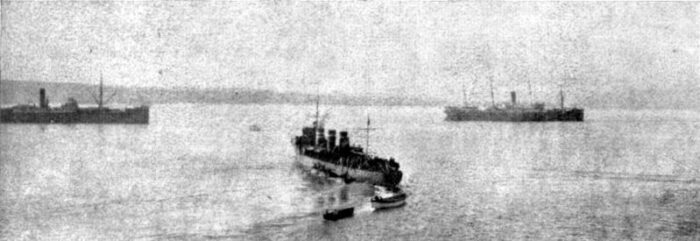
Landings at Anzac Cove 1915, HMS Scourge. Beagles mostly spent their career in the Mediterranean, Dardanelles campaign with the others “old” destroyers of the 1908-1910 classes, and later north Ireland for ASW duties alternating bewteen convoys escorts and patrol areas.
Career of the Beagle class
 HMS Beagle (1909)
HMS Beagle (1909)
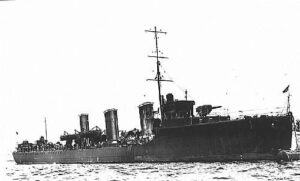 Later given the pennant HC5, HMS Beagle was laid down at John Brown, Clydebank yard on 3.1909, launched on 16.10.1909 and completed on 4.1910, commissioned on 10 June 1910 under Lt. Lionel J.G. Anderson, First Destroyer Flotilla, First Division Home Fleet, tender HMS Blake. On 23 June 1911 she took part in the Coronation Naval Review (King George V), Spithead. 1 May 1912, 3rd Destroyer Flotilla, tender HMS Blenheim. Moved to the Mediterranean as the 5th Destroyer Flotilla, tender Blenheim. She was part of the search for Goeben and Breslau. On 3 August, the 3rd Division, 5th Flotilla (Beagle, Bulldog, Grasshopper and Harpy) were based in Malta and on 6 August, Beagle and Bulldog escorted the cruiser Dublin as both Goeben and Breslau had been spotted by Gloucester east of the Straits of Messina. Dublin tried to intercept them and prepared for a night torpedo attack off Zante. Breslau was sighted and chased until redirected on the more important Goeben, loosing her in the night.
Later given the pennant HC5, HMS Beagle was laid down at John Brown, Clydebank yard on 3.1909, launched on 16.10.1909 and completed on 4.1910, commissioned on 10 June 1910 under Lt. Lionel J.G. Anderson, First Destroyer Flotilla, First Division Home Fleet, tender HMS Blake. On 23 June 1911 she took part in the Coronation Naval Review (King George V), Spithead. 1 May 1912, 3rd Destroyer Flotilla, tender HMS Blenheim. Moved to the Mediterranean as the 5th Destroyer Flotilla, tender Blenheim. She was part of the search for Goeben and Breslau. On 3 August, the 3rd Division, 5th Flotilla (Beagle, Bulldog, Grasshopper and Harpy) were based in Malta and on 6 August, Beagle and Bulldog escorted the cruiser Dublin as both Goeben and Breslau had been spotted by Gloucester east of the Straits of Messina. Dublin tried to intercept them and prepared for a night torpedo attack off Zante. Breslau was sighted and chased until redirected on the more important Goeben, loosing her in the night.
On 9 August was was in Port Vathi, Ithaca west coast of Greece. Short of coal they waited for a collier and started to establish a patrol line in the Aegean Sea off the Dardanelles. By November 1914, a shortage of destroyers in home waters meant all were recalled to Britain, and she arrived in Plymouth on 29 November, operateed from there to protect cross-Channel transports (BEF General French). Instead of filling the new 10th Destroyer Flotilla at Harwich, they remained at Portsmouth.
On 26 March 1915 after failing to take the Dardanelles the eight Beagles were ordered back to Mudros. On 25 April 1915, Beagle protected the Landing at Anzac Cove, shelling on demand Turkish positions for the 9th Battalion, Royal Queensland Rgt. She was then sent to protect the preadnought battleships HMS Goliath and Cornwallis in Morto Bay to support French troops. Beagle and Bulldog patrolled the north straits. But the Turkish destroyer Muavenet-i Milliye sneak past them and torpedoed and sunk Goliath.
On 28 June Beagle, Bulldog, Racoon and Basilisk escorted the cruiser Talbot at the Battle of Gully Ravine. Again on 6–7 August 1915 at Suvla Bay where Beagle, Bulldog and Grampus landed troops of the 34th Brigade, having 500 aboard each and towing a “Beetle” wuth 500 more troops. The latter returned to the DDs to take on and carry the remainder of troops to the shore. The battle of Nibrunesi beach was a success, not at Sulva Bay. The “Beetles” ran aground off shore, the remaining troops were landed by their own service boats, this took until 5:00 AM on 7 August. Later she covered the evacuations from Anzac Cove on 20 December.
On 13 December 1916 Beagle and Racoon engaged by error an aircraft off Kum Kale. HMS Racoon later rescued the French pilot and observer, sent to Kephelo Air Base, Imbros. On 9 January 1917, Beagle escorted HMS Cornwallis from Mudros to Malta, when she was torpedoed by U-32. Damage control failed and Beagle took off her crew, just after this U-32 hit the battleships with a 3rd torpedo. Beagle tried to depth charge her but missed.
In mid-1917 she was reassigned in home water by the Admiralty, 2nd Destroyer Flotilla at Buncrana, Lough Swilly (N Ireland) by October 1917. She aletrnated ASW patrols and convoy escort, North West Approaches until V-Day. March 1919 she was laid up in reserve, Nore, sold April 1920, done on 1 November 1921, BU.
 HMS Bulldog
HMS Bulldog
HMS Bulldog (HC7, HC4) was laid down at John Brown, Clydebank on march 1909 launched on 13.11.1909 and completed in July 1910, commissioned on 7 July, assigned to the 1st Destroyer Flotilla, 1st Division Home Fleet, HMS Blake. March 1911, she cruised to Norway, Trondheim on 6 March. 1 May 1912, 3rd Destroyer Flotilla, HMS Blenheim, tender. October 1913, 5th Destroyer Flotilla, HMS Blenheim later sent to the Mediterranean, Malta.
9 August 1914 with Beagle she was at Port Vathi awaiting the arrival of a collier, and afterwards creating a patrol line in the Aegean Sea to blockage Yavuz and Midilli (ex-Goeben-Breslau now part of the Ottoman Navy)
In November 1914 she was recalled from the Mediterranean to the Portsmouth Local Flotilla, part of the ‘Mediterranean Beagles’. The initia plan of a 10th Destroyer Flotilla for operations and a landing on the Flanders Coast was cancelled. She was returned to the Med, and took part on the Dardanelles campaign in March 1915 with the 5th Destroyer Flotilla.
On 16 April 1916 while on Patrol she struck a contact mine off Gallipoli. Badly damaged she had on officer killed and six men. Towed to Mudros, Malta for repairs she was back on patrol on 4 December. In mid-1917 she was reassigned to Home Waters, 2nd Destroyer Flotilla, Buncrana, Ireland by October, North West Approaches until Nov. 1918. February 1919 she was laid up in reserve at the Nore. April 1920, on disposal, sold on 21 September 1920 to Thos. W. Ward, BU.
 HMS Grasshopper
HMS Grasshopper
HMS Grasshopper (H17, H60) was laid down at Fairfield, Govan, laid down on 4.1909, launched on 23.11.1909, completed on 7.1910. She was in the 1st Destroyer Flotilla and was refitted at Chatham in July–September 1911. In 1912 she was versed to the 3rd Destroyer Flotilla, until March 1913 but In October 1913 she was moved to the Mediterranean, 5th Destroyer Flotilla until 1914. She took part in the search for Goeben and Breslau and on 3 August was standing at Malta, then patrolling the Straits of Messina by 7 October. In 1915 she took part in the Dardanelles Campaign. On 1/2 March 1915 with Basilisk, Mosquito and Racoon she escorted minesweeper trawlers in the narrows, but they came under heavy fire and failed. Other attempts were unsuccessful and it was decided to do it by day under battleships cover. This started on 8 March, but failed again, Bouvet, Ocean and Irresistible sunk, Gaulois, Suffren badly damaged.
On 25 April she was at Anzac Cove and Cape Helles with Basilisk, Lord Nelson and Cornwallis. She was at Suvla Bay towing a “Beetle” (see above) and took part in the evacuations from Gallipoli on 8/9 January 1916 at Cape Helles.
September 1917 saw her recalled for ASW/escort duties like her sisters, with the 4th Destroyer Flotilla in Devonport, Plymouth. By October she was in the 2nd Destroyer Flotilla in Buncrana and by February 1918, she escorted Convoy HX 20 from Halifax to Liverpool, rescuing c500 men from the troopship Tuscania. By July 1918 she was in the 4th Flotilla at Devonport until November. In January 1919, she was in reserve at the The Nore, sold for scrap on 1 November 1921.
 HMS Harpy
HMS Harpy
HMS Harpy had the pennants D88, H19, H71. She wa slaid down at White, Cowes on 4.1909, launched on 27.11.1909 and completed on 7.1910. To be precised, 29 July and she was versed to the 1st Destroyer Flotilla and in 1912, 3rd until March 1913, the 5th, Mediterranean Fleet, 3rd Division based in Alexandria, before moving to Malta, struck by coal shortage, but she took part in the search for Goeben and Breslau, patrolling the Straits of Messina on 7 October. Next she took part in the Dardanelles Campaign. On 25 May she spotted and drove off a submarine ready to torpedo the battleship Saint Louis. She took part in the reare successful attempts of minesweeping the Dardanelles on 25 and 26 June.
In 1916 she was in frequent ASW patrols and supported raids on the Turkish shores by irregular troops such as the Leros raid of 28 September under Commander H. T. England, which was severely injured. By June 1917, she started to escort local convoys and by October, she joined the Northern Division at Buncrana. She covered one from Hampton Roads and Nova Scotia, Clyde and Mersey. Every eight she covered fast convoys from and to Halifax and she ended the war in the 4th Destroyer Flotilla, Devonport. In February 1919 she was in reserve at The Nore. On 27 November 1921, she sold for BU.
 HMS Renard
HMS Renard
HMS Renard (Fr for “fox”) receveived the pennants H99 and 691, she had been laid down at Cammell Laird, Birkenhead on 4.1909, launched on 30.11.1909 and was completed in September 1910. 1st Destroyer Flotilla 20 Octobe, 15 November 1911 she towed her sister Scorpion after damage in collision with Danish schooner Fyn. 1912, 3rd Destroyer Flotilla, Sheerness on 3 September, relocated at Chatham until March 1913, then November 5th Destroyer Flotilla, Mediterranean Fleet in the 1st Division, Alexandria. She was in Malta on 9 August for the Goeben-Breslau run, took part in the Dardanelles Campaign. She took part in the minesweping attempt of 3 March 1915 with Grampus and Scorpion, escorted the troopship Braemar Castle to Kumkale. On 25-26 June with Rattlesnake she took part in a minsweeping sailf by De Robeck as made in “a most satisfactory manner”. She took part in the evacuations from Cape Helles in 1916.
On 24 July she escorted the monitor M33 and a minesweeper carrying 172 irregular troops for the Mytilene and Smyrn raids, fending off attacks from the Ottoman Aviation Squadrons, they basially stol 3,200 sheep and other animals to feed british troops.
On 20 January 1917 Renard accompanied the Acheron-class HMS Archer escorting a tanker in the 2nd Detached Squadron (Aegean Squadron) based at Pyrgos, Imbros. Escorts went on until November 1918.
By February 1919 she was at The Nore and on 31 August 1920, she was sold for BU.
 HMS Foxhound
HMS Foxhound
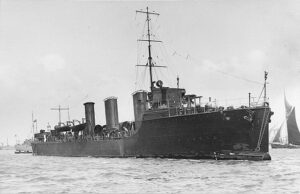 Foxhound H16, Alsi immatriculated H58, Foxhound was laid down at John Brown, Clydebank on 4.1909, launched on 11.12.1909 and completed by May 1910, joining the 1st and 2nd Destroyer Flotillas, 3rd in 1912 until March 1913 and by October Mediterranean 5th, depot ship Blenheim, 2nd Division. She was transferred in Malta on 27 July 1914. She was nbot deployed by Rear Admiral Ernest Troubridge to the entrance to the Adriatic as not having sufficient coal and on 18 August was ordered to Egypt, patrolling the entrance to the Gulf of Aqaba, Red Sea from 23 October. From 21 November she started her Dardanelles, Gallipoli campaign. On 25 April 1915, she covered the Landing at Anzac Cove and on 6–7 August 1915 at Suvla Bay, towing a “Beetle”. On 21 November 1916 she rescued survivors of HMHS Britannic.
Foxhound H16, Alsi immatriculated H58, Foxhound was laid down at John Brown, Clydebank on 4.1909, launched on 11.12.1909 and completed by May 1910, joining the 1st and 2nd Destroyer Flotillas, 3rd in 1912 until March 1913 and by October Mediterranean 5th, depot ship Blenheim, 2nd Division. She was transferred in Malta on 27 July 1914. She was nbot deployed by Rear Admiral Ernest Troubridge to the entrance to the Adriatic as not having sufficient coal and on 18 August was ordered to Egypt, patrolling the entrance to the Gulf of Aqaba, Red Sea from 23 October. From 21 November she started her Dardanelles, Gallipoli campaign. On 25 April 1915, she covered the Landing at Anzac Cove and on 6–7 August 1915 at Suvla Bay, towing a “Beetle”. On 21 November 1916 she rescued survivors of HMHS Britannic.
In October 1917 she was ordered back to Home waters, 2nd Destroyer Flotilla at Buncrana until April 1918, and in June, joined the 4th Destroyer Flotilla at Devonport. In July 1918 she was sent to intercept a German cruiser submarine reported by room 40. She led one of the five divisions of hydrophone-equipped trawlers in the Faroe Islands and Shetland. One was reported and she dropped depth charges but the submarine escaped. By November 1918 she joined the 2nd Flotilla at Buncrana. Like her sisters she was The Nore in January 1919, in July in reserve, stricken, sold for scrap on 1 November 1921.
 HLS Wolverine
HLS Wolverine
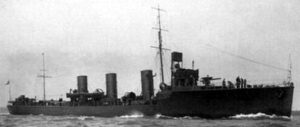 Wolverine (pennants H18, 692) was laid down at Cammell Laird, Birkenhead, in April 1909, launched on 15 January 1910 and completed in September 1910. She served with the 1st Destroyer Flotilla, Home Fleet, 3rd in 1912, until August 1913, then 5th, Mediterranean Fleet in November.
Wolverine (pennants H18, 692) was laid down at Cammell Laird, Birkenhead, in April 1909, launched on 15 January 1910 and completed in September 1910. She served with the 1st Destroyer Flotilla, Home Fleet, 3rd in 1912, until August 1913, then 5th, Mediterranean Fleet in November.
She was not involved in the pursuit of Goeben and Breslau, stuck at Malta. On 1 November 1914 with Scorpion she spotted and sank a Turkish armed yacht, believed to be minelaying the Gulf of Smyrna.
In 1915 with the rest of the Beagle, River and Laforey-class destroyers she took part in the Dardanelles Campaign. Minesweeping attemps, landing at Cape Helles. On 28 April she assisted her sister Racoon by using a weep wire run between ships until hit on her bridge by a Turkish shell, killing Cdr Osmond J. Prentis and two more officers. On the night of 12/13 May, Goliath and Cornwallis had to be protected by Beagle and Bulldog but Muavenet-i Milliye sneak past then and sank Goliath.
She supported the Cape Helles beachhead on 28 June in the Battle of Gully Ravine, repelling by gunfire a Turkish counter attack and later covered the evacuation from Cape Helles on 8/9 January 1916. From March she patrolled the Aegean, Dodecanese, Sporades and Cyclades as well as the Turkish coast, performing raiding parties with irregular Greek and Cretans commanded by John Myres.
Wolverine was recalled to home waters, 2nd Destroyer Flotilla at Buncrana by October 1917. On 12 December 1917 as part of an escort group joining an Atlantic convoy off the northwest coast of Ireland, the senior officer aboard Hardy ordered a course change which caused her to be rammed by the fleet sweeping sloop Rosemary. She rolled over but sank slowly after flooding, with 2 of the crew killed and it was later was blamed on Rosemary’s bridge crew and watch officer making a too early course change, then reversed the manoeuvre.
 HMS Mosquito
HMS Mosquito
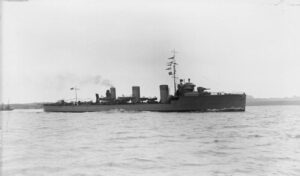 Mosquito (pennant HA3) was laid down at Fairfield, Govan on 4.1909, launched on 27.1.1910 and completed in August 1910. 1st Destroyer Flotilla, 3rd in March 1913, Plymouth, from 19 November 5th Destroyer Flotilla, Mediterranean Fleet. She was based at Alexandria and on 18 August, deployed to Suez. She escorted the ex-Union-Castle Line troopship Grantully Castle with Suffolk Regiment from Port Sudan to Suez on 9 October and the folliwing day she was deployed at Port Sudan.
Mosquito (pennant HA3) was laid down at Fairfield, Govan on 4.1909, launched on 27.1.1910 and completed in August 1910. 1st Destroyer Flotilla, 3rd in March 1913, Plymouth, from 19 November 5th Destroyer Flotilla, Mediterranean Fleet. She was based at Alexandria and on 18 August, deployed to Suez. She escorted the ex-Union-Castle Line troopship Grantully Castle with Suffolk Regiment from Port Sudan to Suez on 9 October and the folliwing day she was deployed at Port Sudan.
In 1915 she was part of the Dardanelles Campaign, part of the failed minesweeping attempt in the night of 1/2 March with Basilisk, Grasshopper and Racoon and 18/19 March. On 18 March, again when Bouvet, Ocean and Irresistible hit mines. By October 1917, she was recalled to the 2nd Destroyer Flotilla at Buncrana. On 5 February 1918 she escorted Convoy HX 20, bound from Halifax and rescued men from the troopship Tuscania sunk by UB-77 south west of Islay. By July 1918, she was versed to the 5th Destroyer Flotilla at Devonport. By February 1919, The Nore, reserve, stricke, sold for BU 31 August 1920.
 HMS Basilisk
HMS Basilisk
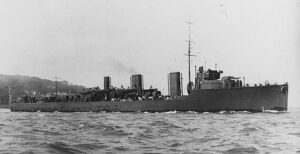 Basilisk (pennants D89, HC8) was laid down at White, Cowes in May 1909, launched on 9 Feb. 1910 and completed by Sept. 1910. She served at Portsmouth with the First Destroyer Flotilla from 17 September, from 1912, 3rd until March 1913, then 5th Mediterranean, 2nd Division in Alexandria. On 9 August she was sent to Malta. 18 August, she was deployed to Suez. From 25 October she patrolled the Gulf and aletrnated Suez Canal and Red Sea routes.
Basilisk (pennants D89, HC8) was laid down at White, Cowes in May 1909, launched on 9 Feb. 1910 and completed by Sept. 1910. She served at Portsmouth with the First Destroyer Flotilla from 17 September, from 1912, 3rd until March 1913, then 5th Mediterranean, 2nd Division in Alexandria. On 9 August she was sent to Malta. 18 August, she was deployed to Suez. From 25 October she patrolled the Gulf and aletrnated Suez Canal and Red Sea routes.
On 19 November, she was sent to Tenedos for the Dardanelles Campaign. Sje covered the pre-dreadnought battleships Albion, Majestic and Triumph. On 26 February 1915 with Racoon she escorted the battleships Cornwallis, Irresistible and Vengeance shelling batteries. She took part in the minesweeping raids of 1/2 March and another later. On 6 August, she took part in the Suvla Bay assauled escorted by Chatham, flagship, Admiral Rosslyn Wemyss. She ecorted convoys between Malta and Egypt, and on 20 January 1918, she covered the monitors M29 and M32 from Alexandria in their missions.
By February 1919 she was at The Nore, reserve, stricke, sold for BU 1 November 1921.
 HMS Scourge
HMS Scourge
 Scourge (pennants D96, H8A) was from Hawthorn Leslie, Hebburn, laid down on 3.1909, launched on 11.2.1910 and completed in August 1910. Logs are about the same as the rest of the class. So in short, she was present at Suvla Bay on 6–7 August 1915, carrying troops to shore with “beetles” along with a Portuguese destroyer and assisted with the rescue of HMHS Britannic’s survivors, medical personnel and crew members. Initially it was her which received SOS and CQD from the Kea Channel and was the fist on location. She picked up 339 survivors and transferred them on Kea Island, later picked up by other ships afterwards. She remained in the Med all the war, in Feb 1919 she was at The Nore, placed in reserve and sold for scrap, 9 May 1921.
Scourge (pennants D96, H8A) was from Hawthorn Leslie, Hebburn, laid down on 3.1909, launched on 11.2.1910 and completed in August 1910. Logs are about the same as the rest of the class. So in short, she was present at Suvla Bay on 6–7 August 1915, carrying troops to shore with “beetles” along with a Portuguese destroyer and assisted with the rescue of HMHS Britannic’s survivors, medical personnel and crew members. Initially it was her which received SOS and CQD from the Kea Channel and was the fist on location. She picked up 339 survivors and transferred them on Kea Island, later picked up by other ships afterwards. She remained in the Med all the war, in Feb 1919 she was at The Nore, placed in reserve and sold for scrap, 9 May 1921.
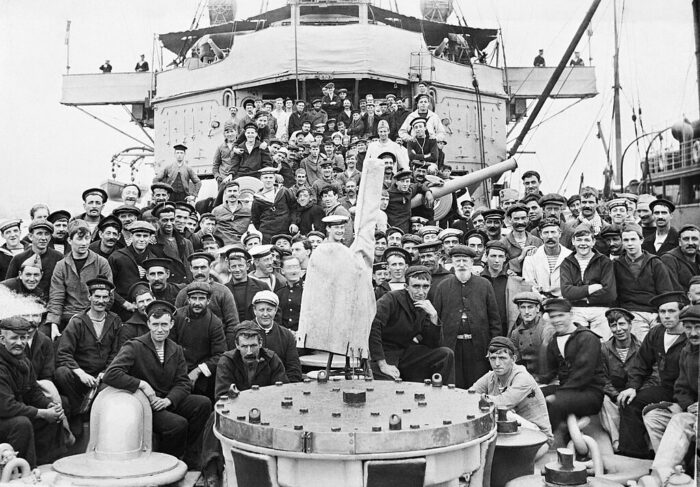
The survivors of HMHS (Hospital’s Majesty Ship) Britannic, sister ship of Titatic for an historical photo
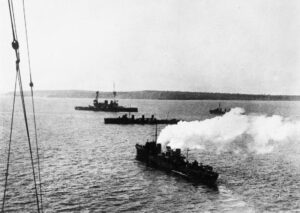 HMS Racoon (pennants HA7, 693) was built at Cammell Laird, Birkenhead, laid down 5.1909, launched on 15 Feb. 1910, completed by October 1910, commissioned at Portsmouth, then 1st Destroyer Flotilla, Malta from 14 March 1911, 1912, 3rd Destroyer Flotilla, Sheerness 12 January, Harwich and by March 1913 5th Destroyer Flotilla Mediterranean Fleet. She was based in Durazzo in 1914 with the armoured cruiser Defence, Rear Admiral Ernest Troubridge that were monitoring Albania pressured to join the central empires. She was at Malta on 29 July, not deployed for Goeben and Breslau and on 13 August, deployed to Suez and Red Sea and escorting the Grantully Castle to Malta on 9 October. On the 25th she looked for mines in the Gulf of Suez. On 19 November, she was based in Tenedos for the Dardanelles Campaign. She escorted the pre-dreadnought battleships Albion, Majestic and Triumph and on 26 February, Cornwallis, Irresistible and Vengeance, then the failed raid on 1/2 March and 17/18 March and on the 19th. Racoon was also damaged by a mine or shell when stopped to rescue the crew of Irresistible, she was repaired, and back on 28 June to escort the protected cruiser Talbot supporting the Lowland Division, Battle of Gully Ravine. On 6 August, she carried the IX Corps to Suvla Bay. March 1917 saw her hearing and drop charges on an U-Boat while escorting the troopship Osmanieh. In October she joined the 2nd at Buncrana but on 4 January 1918, she ran aground in a snowstorm off the Irish coast and sank with all hands.
HMS Racoon (pennants HA7, 693) was built at Cammell Laird, Birkenhead, laid down 5.1909, launched on 15 Feb. 1910, completed by October 1910, commissioned at Portsmouth, then 1st Destroyer Flotilla, Malta from 14 March 1911, 1912, 3rd Destroyer Flotilla, Sheerness 12 January, Harwich and by March 1913 5th Destroyer Flotilla Mediterranean Fleet. She was based in Durazzo in 1914 with the armoured cruiser Defence, Rear Admiral Ernest Troubridge that were monitoring Albania pressured to join the central empires. She was at Malta on 29 July, not deployed for Goeben and Breslau and on 13 August, deployed to Suez and Red Sea and escorting the Grantully Castle to Malta on 9 October. On the 25th she looked for mines in the Gulf of Suez. On 19 November, she was based in Tenedos for the Dardanelles Campaign. She escorted the pre-dreadnought battleships Albion, Majestic and Triumph and on 26 February, Cornwallis, Irresistible and Vengeance, then the failed raid on 1/2 March and 17/18 March and on the 19th. Racoon was also damaged by a mine or shell when stopped to rescue the crew of Irresistible, she was repaired, and back on 28 June to escort the protected cruiser Talbot supporting the Lowland Division, Battle of Gully Ravine. On 6 August, she carried the IX Corps to Suvla Bay. March 1917 saw her hearing and drop charges on an U-Boat while escorting the troopship Osmanieh. In October she joined the 2nd at Buncrana but on 4 January 1918, she ran aground in a snowstorm off the Irish coast and sank with all hands.
 HMS Scorpion
HMS Scorpion
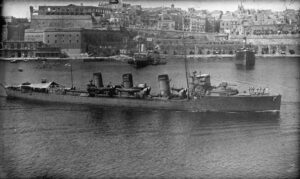 Scorpion (D90, HC3) was laid down at Fairfield, Govan in May 1909 , launched on 19 February 1910 and completed by August 1910. 1st flotilla, she was under command of no other than Lieutenant-Commander Andrew Cunningham, from January 1911 to January 1918. Formative years to say the least for the man that won the Mediterranean campaign in WW2. She took part in the Naval Review of 1911 with 42 battleships and 68 destroyers. On 15 November 1911 she collided with the Danish schooner Fyn while returning to Harwich after exercises in the Channel, holed close to her engine room, towed to port by Renard, but flooding was so severe she was ran aground and abandoned near the Goodwin Sands. She was later refloated, towed and repaired at Chatham Dockyard. By 1912 she was in the 3rd Destroyer Flotilla and in 1913, 5th Destroyer Flotilla. In Malta she was left behind during the Goeben and cruiser Breslau chase. On 1 November 1914 with Wolverine she sank the Turkish armed yacht Beyrout in Vourla harbour. Dardanelles Campaign: Escortedg minesweeping trawlers 3/4 March 1915 and on 4 March, covered Royal Marines landed at Kum Kale and Sedd el Bahr. She knocked out a gun battery, but the position was evacuated and her cutter picked up 7 RMs. No more records. She operated in the Med likely until the end of the war, The Nore reserve 1919, Sold for BU 26 October 1921.
Scorpion (D90, HC3) was laid down at Fairfield, Govan in May 1909 , launched on 19 February 1910 and completed by August 1910. 1st flotilla, she was under command of no other than Lieutenant-Commander Andrew Cunningham, from January 1911 to January 1918. Formative years to say the least for the man that won the Mediterranean campaign in WW2. She took part in the Naval Review of 1911 with 42 battleships and 68 destroyers. On 15 November 1911 she collided with the Danish schooner Fyn while returning to Harwich after exercises in the Channel, holed close to her engine room, towed to port by Renard, but flooding was so severe she was ran aground and abandoned near the Goodwin Sands. She was later refloated, towed and repaired at Chatham Dockyard. By 1912 she was in the 3rd Destroyer Flotilla and in 1913, 5th Destroyer Flotilla. In Malta she was left behind during the Goeben and cruiser Breslau chase. On 1 November 1914 with Wolverine she sank the Turkish armed yacht Beyrout in Vourla harbour. Dardanelles Campaign: Escortedg minesweeping trawlers 3/4 March 1915 and on 4 March, covered Royal Marines landed at Kum Kale and Sedd el Bahr. She knocked out a gun battery, but the position was evacuated and her cutter picked up 7 RMs. No more records. She operated in the Med likely until the end of the war, The Nore reserve 1919, Sold for BU 26 October 1921.
 HMS Savage
HMS Savage
Savage (D92, HA9) was laid down at Thornycroft, Woolston on 3.1909, launched on 10.3.1910, completed 8.1910. No records, sold for BU 5.1921.
 HMS Rattlesnake
HMS Rattlesnake
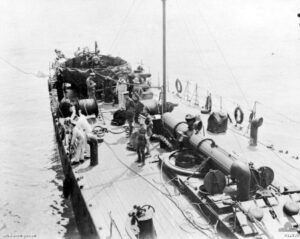 Rattlesnake (D94, HC7) was laid down at London & Glasgow Co, Govan on 4.1909, launched on 14.3.1910 and completed on 8.1910, she was sold for BU 5.1921. She joined the 2nd Destroyer Flotilla and in 1912, 3rd, 31 October 1913, 5th Destroyer Flotilla, Mediterranean. The photo here showed Sir Ian Hamilton, commander of the Mediterranean Expeditionary Force during the Dardanelles Campaign on her poop by April 1915.
Rattlesnake (D94, HC7) was laid down at London & Glasgow Co, Govan on 4.1909, launched on 14.3.1910 and completed on 8.1910, she was sold for BU 5.1921. She joined the 2nd Destroyer Flotilla and in 1912, 3rd, 31 October 1913, 5th Destroyer Flotilla, Mediterranean. The photo here showed Sir Ian Hamilton, commander of the Mediterranean Expeditionary Force during the Dardanelles Campaign on her poop by April 1915.
She was in the 4rth Division, 5th Flotilla in Alexandria, Malta on 29 July, escorted Indomitable to Bizerta to coal, but she was plagued by fuel shortage. In the Dardanelles she covered the Australian 1st Division on 27 May at Kabatepe, using her searchlight to identified Ottoman trenches and fire on them, destroying a large communications line and again on 18 December. She remained woith the 5th Flotilla, transferred to the Aegean Squadron. 20 January saw her detached to Gibraltar, then 2nd Flotilla at Buncrana where she escorted convoys from the American industrial complex at Hampton Roads via Sydney in Nova Scotia to Clyde-Mersey. February 1919, Portsmouth, discarded, sold 9 May 1921.
 HMS Pincher
HMS Pincher
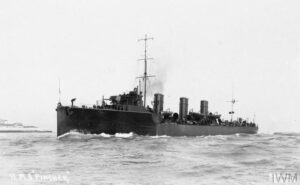 Pincher (D87, HC2) was laid down at Denny, Dumbarton in May 1909, launched 15 March 1910 completed Sept. 1910. She joined the 1st and 2nd Destroyer Flotillas, 3rd in 1912, and 5th Med by October 1913. Left behind in the Goeben-Breslau chase. Escorted the battlecruisers Inflexible and Indefatigable, cruisers Chatham and Weymouth west of Sicily, into Bizerte on 6 August, captured German the merchant ships Kawak and Kalymnos in port.
Pincher (D87, HC2) was laid down at Denny, Dumbarton in May 1909, launched 15 March 1910 completed Sept. 1910. She joined the 1st and 2nd Destroyer Flotillas, 3rd in 1912, and 5th Med by October 1913. Left behind in the Goeben-Breslau chase. Escorted the battlecruisers Inflexible and Indefatigable, cruisers Chatham and Weymouth west of Sicily, into Bizerte on 6 August, captured German the merchant ships Kawak and Kalymnos in port.
November 1914 she was recalled to Britain, Plymouth on 29 November, escorted cross-Channel transport, 26 March 1915 sent for the Dardanelles campaign to the 5th Flotilla in Mudros: Landings at ANZAC Cove, Cape Helles, minesweeping raid of 12/13 May, missed Muavenet-i Milliye which sank Goliath. March 1916 she patrolled the Aegean sea. 2 January 1918, overhaul at Pembroke Dock, 2nd Destroyer Flotilla, Buncrana. June 1918, transferred to the 4th Destroyer Flotilla, Devonport.
24 July 1918, escortied the Standard Tanker “War Hostage” from Devonport through the Western Approaches alongside HMS Scorpion, making a course change to the Seven Stones Reef between Cornwall and the Isles of Scilly in fog and hit the reef at high speed. She sank at 03:33. Lieutenant Patrick W.R. Weir was court-martialled for unsafe course.
 HMS Grampus
HMS Grampus
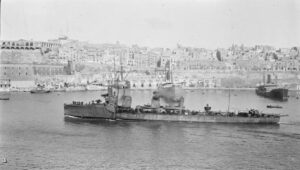 Laid down as HMS Nautilus, renamed 12.1913 Grampus oto free the name for a British sub., pennants H07, H38, HA7. Built at Thames Iron Works, Blackwall, laid down 4.1909, launched 30.3.1910 and completed in Sept. 1911. 1st Destroyer Flotilla from 12 September, replacing the River-class destroyer Rother. Dardanelles Campaign, 17 April 1915, rescue and later sinking attempt of submarine HMS E15 which ran aground under Kephaz Point (Lieutenant Commander T. S. Brodie) with her crew taken prisoner. She could not locate E15.
Laid down as HMS Nautilus, renamed 12.1913 Grampus oto free the name for a British sub., pennants H07, H38, HA7. Built at Thames Iron Works, Blackwall, laid down 4.1909, launched 30.3.1910 and completed in Sept. 1911. 1st Destroyer Flotilla from 12 September, replacing the River-class destroyer Rother. Dardanelles Campaign, 17 April 1915, rescue and later sinking attempt of submarine HMS E15 which ran aground under Kephaz Point (Lieutenant Commander T. S. Brodie) with her crew taken prisoner. She could not locate E15.
On 6 August, she landed 11th Battalion, Manchester Regiment, 11th Division in Suvla Bay but wrong part of beach. Ill-supplied on 8 August she managed to sent them one of her own water tanks, loose floated ashore. No records afterwards. She ended in reserve in 1919, was sold to Thos. W. Ward for scrapping at Rainham, Kent on 21 September 1920. The latter obtained most of the class to breakup.
Read More/Src
Books
Naval Matters—Past and Prospective: Sheerness Dockyard”. The Marine Engineer and Naval Architect. Vol. 34. August 1911.
Conway’s all the world’s fighting ships 1906-1921 p.73-74
Brown, David K. (2010). The Grand Fleet: Warship Design and Development 1906–1922. Barnsley, UK: Seaforth Publishing.
Colledge, J. J.; Warlow, Ben (2006) [1969]. Ships of the Royal Navy: The Complete Record of all Fighting Ships of the Royal Navy. Chatham Publishing.
Dittmar, F. J.; Colledge, J.J. (1972). British Warships 1914–1919. Shepperton, UK: Ian Allan.
Friedman, Norman (2009). British Destroyers: From Earliest Days to the Second World War. Barnsley, UK: Seaforth Publishing.
Manning, T.D. (1961). The British Destroyer. London: Putnam.
Moore, John (1990). Jane’s Fighting Ships of World War I. London: Studio.
Links
pbenyon.plus.com
http://www.clydesite.co.uk
web.archive.org/ naval-history.net/ WW1NavyBritishBattleHonours.htm
battleships-cruisers.co.uk/ beagle_class
dreadnoughtproject.org Beagle_Class_Destroyer
navypedia.org/ g_basilisk.htm
rmg.co.uk/ coll. beagle class yard model: grasshopper
en.wikipedia.org/ Beagle-class_destroyer
Model Kits
Royal Navy G-Class Destroyer HMS Beagle – 1909 Combrig | No. 70634PE | 1:700

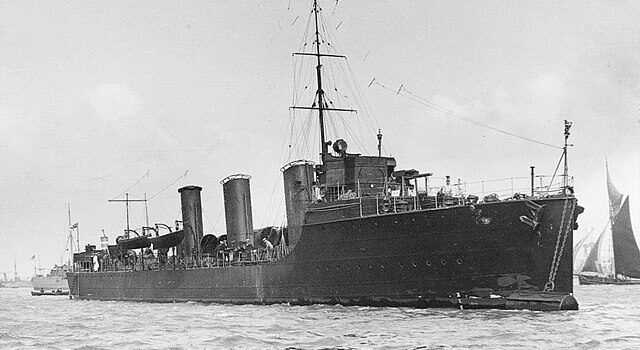
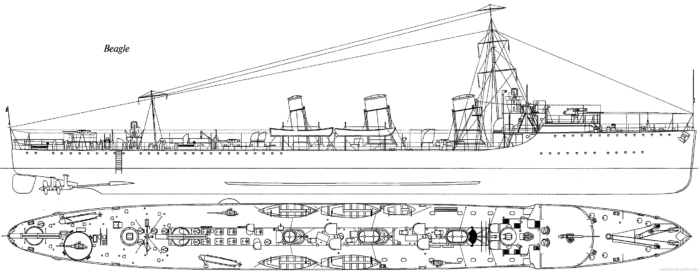
 Latest Facebook Entry -
Latest Facebook Entry -  X(Tweeter) Naval Encyclopedia's deck archive
X(Tweeter) Naval Encyclopedia's deck archive Instagram (@navalencyc)
Instagram (@navalencyc)





 French Navy
French Navy Royal Navy
Royal Navy Russian Navy
Russian Navy Armada Espanola
Armada Espanola Austrian Navy
Austrian Navy K.u.K. Kriegsmarine
K.u.K. Kriegsmarine Dansk Marine
Dansk Marine Nautiko Hellenon
Nautiko Hellenon Koninklije Marine 1870
Koninklije Marine 1870 Marinha do Brasil
Marinha do Brasil Osmanlı Donanması
Osmanlı Donanması Marina Do Peru
Marina Do Peru Marinha do Portugal
Marinha do Portugal Regia Marina 1870
Regia Marina 1870 Nihhon Kaigun 1870
Nihhon Kaigun 1870 Preußische Marine 1870
Preußische Marine 1870 Russkiy Flot 1870
Russkiy Flot 1870 Svenska marinen
Svenska marinen Søværnet
Søværnet Union Navy
Union Navy Confederate Navy
Confederate Navy Armada de Argentina
Armada de Argentina Imperial Chinese Navy
Imperial Chinese Navy Marinha do Portugal
Marinha do Portugal Mexico
Mexico Kaiserliche Marine
Kaiserliche Marine 1898 US Navy
1898 US Navy Sovietskiy Flot
Sovietskiy Flot Royal Canadian Navy
Royal Canadian Navy Royal Australian Navy
Royal Australian Navy RNZN Fleet
RNZN Fleet Chinese Navy 1937
Chinese Navy 1937 Kriegsmarine
Kriegsmarine Chilean Navy
Chilean Navy Danish Navy
Danish Navy Finnish Navy
Finnish Navy Hellenic Navy
Hellenic Navy Polish Navy
Polish Navy Romanian Navy
Romanian Navy Turkish Navy
Turkish Navy Royal Yugoslav Navy
Royal Yugoslav Navy Royal Thai Navy
Royal Thai Navy Minor Navies
Minor Navies Albania
Albania Austria
Austria Belgium
Belgium Columbia
Columbia Costa Rica
Costa Rica Cuba
Cuba Czechoslovakia
Czechoslovakia Dominican Republic
Dominican Republic Haiti
Haiti Hungary
Hungary Honduras
Honduras Estonia
Estonia Iceland
Iceland Eire
Eire Equador
Equador Iran
Iran Iraq
Iraq Latvia
Latvia Liberia
Liberia Lithuania
Lithuania Mandchukuo
Mandchukuo Morocco
Morocco Nicaragua
Nicaragua Persia
Persia San Salvador
San Salvador Sarawak
Sarawak Uruguay
Uruguay Venezuela
Venezuela Zanzibar
Zanzibar Warsaw Pact Navies
Warsaw Pact Navies Bulgaria
Bulgaria Hungary
Hungary

 Bundesmarine
Bundesmarine Dutch Navy
Dutch Navy Hellenic Navy
Hellenic Navy Marina Militare
Marina Militare Yugoslav Navy
Yugoslav Navy Chinese Navy
Chinese Navy Indian Navy
Indian Navy Indonesian Navy
Indonesian Navy JMSDF
JMSDF North Korean Navy
North Korean Navy Pakistani Navy
Pakistani Navy Philippines Navy
Philippines Navy ROKN
ROKN Rep. of Singapore Navy
Rep. of Singapore Navy Taiwanese Navy
Taiwanese Navy IDF Navy
IDF Navy Saudi Navy
Saudi Navy Royal New Zealand Navy
Royal New Zealand Navy Egyptian Navy
Egyptian Navy South African Navy
South African Navy






























 Ukrainian Navy
Ukrainian Navy dbodesign
dbodesign